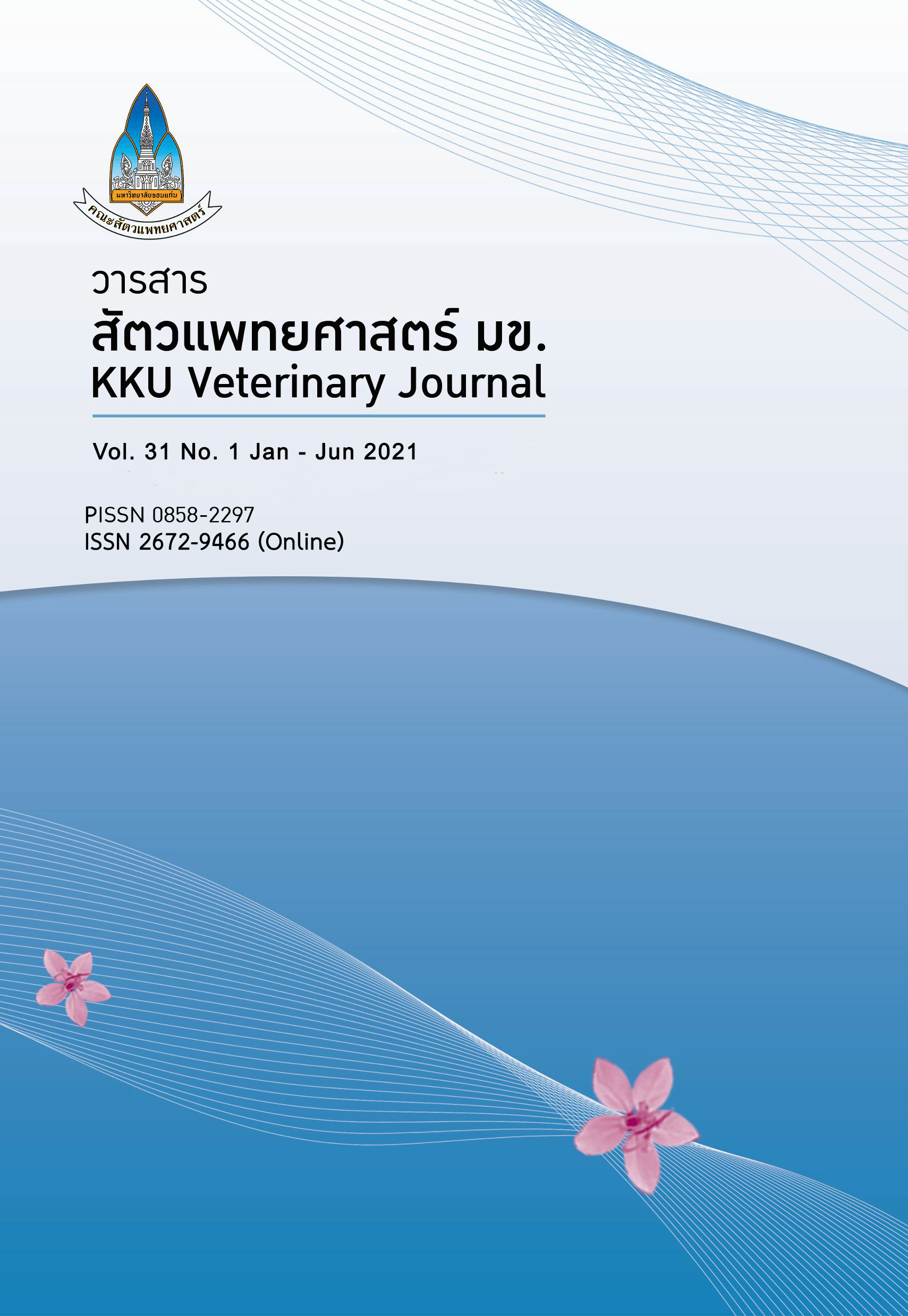Influence of manila palm (Veitchia merrillii Becc.) powder on production performance, feed intake and hematology in beef cattle
Main Article Content
Abstract
Objective: To study the level of manila palm (Veitchia merrillii Becc.) on production performance, feed intake and hematology in beef cattles.
Materials and methods: Five female brahman crossbred beef cattle, aged 1-2 years, mean weight 240±40 kg, were plotted in a 5x5 Latin square design experiment to compare 5 herbs formulation of manila palm powder supplement. Control group received concentrate diet curde protein (CP) 16 % (no manila palm powder was given). Treatment 2 received 1 ml of Ivermactin deworming per 50 kg weight of cattle. Treatment 3, 4 and 5 were supplemented with manila palm powder 1%, 3% and 5% of concentrate, respectively.
Results: Beef cattle fed all 5 treatments found that feed conversion ratio (FCR), blood urea nitrogen (BUN) and hematocrit (Hct) were not statistically different (P>0.05), while beef cattle fed with treatment 5 were highly voluntary feed intake when calculated in percentage of body weight and gram/metabolic weight. In addition, the average daily gain/head/day beef cattle fed with manila palm (Veitchia merrillii Becc.) powder and Ivermactin were higher than the control group (P<0.05).
Conclusion: Manila palm powder can improve production performance, voluntary feed intake. The supplement by manila palm powder can be used up to 5% of concentrate in beef cattle, and improve voluntary feed intake, FCR and average daily gain/head/day.
Keywords: manila palm powder, production performance, beef cattle
Article Details

This work is licensed under a Creative Commons Attribution-NonCommercial-NoDerivatives 4.0 International License.
References
AOCA, 1985. Official Methods of Analysis. Washington, D.C., USA: Association Official Analysis Chemists.
Boonprong S, 2015. Beef cattle farming guide for Thai farmers. Department of Livestock Development Publishing, Bangkok.
Bassey S. Antia, Emmanuel E. Essien, Enobong D. Udonkanga, 2008. Nutritional Composition and Acute Toxicity Potentials of Archontophoenix tukeri and Adonidia merrilli Kernels. UK J Pharm Biosci 5(3), 01-08.
Crocker CL, 1967. Rapid determination of urea nitrogen in serum or plasma without deproteinization. Amer J Med Techn 33, 361.
Du ZM, Wan XX, Wu AC, 1999. Effect of arecoline on spontaneous peristalsis of isolated ileum. J PLA Jun Cil Med 27, 87–88.
Dransfield J, Uhl NW, Asmussen-Lange CB, Baker WJ, Harley MM, Lewis CE, 2008. Genera Palmarum Evolution and Classification of the Palms. Royal Botanic Gardens, Kew.
Goering HK, and Van SPJ, 1970. Washington, D.C., U.S.A.: United states Department of Agriculture.
Gritsanapan W, 1994. anti herb roundworm drug advancement and antimicrobial Herbs. Bangkok : T.P. Co., Ltd. Print.
Hammond AC, 1983. Use of blood urea nitrogen concentration as an indicator of protein status in cattle. Bov Pract 18, 114-118.
Hasanah RA, 2016. ‘Standarisasi dan uji aktivitas antibaktei ekstrak biji palem putri (Adonidia merrillii (Becc.) Becc.) terhadap Staphylococcus aureus dan Escherichia coli’, Scription Dept of Pharmact Faculty of Science Sriwijaya University.
Khuttiyo J, Seksom A, Yuwares R, 2014. Effects of Alkaloid Extracts on Growth Response and Gut Histology of Nursery Pigs. Kasetsart University Kamphaeng Saen Campus Conference. 11 : 1642-1648.
Klinthong S, 2002. Helminthiasis in dairy cows. [Cited 2021 May 15]. Available from: http:// www.dld.go.th/inform/article/article23.html.
Kirtikar, KR, Basu, BD, 1980. Indian Medicinal Plants; plates, Part I, The Panin Office, Bahadurganj, Allahabad, India, Plate. No. 102.
Limcharoen S, 2014. Anthelmintic Activity of Tamarind Seeds Against Parasites in American Brahman Crossbred. National Research Council of Thailand (NRCT).
Agriculture M and Cooperatives, 2020. Accelerate the construction of the Chiang Saen standard beef cattle center. [Cited 2021 May 15]. Available from: https://www.moac.go.th/news-preview-422891792237.
Narathimat Provincial Livestock Office, 2006. The number of buffaloes, pigs, goats, sheep is separated into the number raised and the number. Farmers listed in the province. Information And Statistical Center Group Department of Livestock Information. [Cited 2021 May 15]. Available from:www.did.go.th/ict/yearly/yearly49/stockl/report% 207.xls.
Preston RL, Schnakanberg DD, Pfander WH, 1965. Protein utilization in ruminants. I. Blood urea nitrogen as affected by protein intake. J Nutr 86, 281-287.
SAS, 1985. User,s Guide:Statistic. SAS. nstCary, NC.
Steel RGD, Torrie JH, 1985. Principles and Procedureof Statistics. McGraw-Hill Publishing Co., New York.
Shan LM, Zhang JC, Zhao YL, 2004. Molecular mechanisms for arecoline against atherosclerosis. Chin Pharmacol Bull 20, 146–149.
Si CF, Wei MX, Kyoshi N, 2004. A study of the effects of arecaline hydrobromide on the dispersed colonic smooth muscle cells in tats. Shanghai J Trad Chin Med 38, 48–50.
Srisaikham S, 2014. Effects of neem (Azadirachta indica a. Juss. var. Siamensis valeton) Foliage Utilization in meat goat diets on rumen fermentation and productive performances. A Thesis Submitted in Partial Fulfillment of the Requirements for the Degree of Master of Science in Animal Production Technology Suranaree University of Technology.
Uanpromma S, Papirom P, Chukanhom K, Chanlun S, Saengpol S, Ponyawon, 2006. Survey of gastrointestinal parasites in native cattle and buffalo in mahasarakam province. J Thai Vet Med Assoc 57(3), 26-36.
Wongnen C, Krittika K, Pijug S, Witsanu p, Julawan J, 2019. Effects of tannin sources supplementation on internal nematodes infections in goats. Khon Kaen Agr J 47 suppl 2, 893-898.
Wanapat M, 1986. Ruminant nutrition. Department of Animal Science, Khon Kaen University.
Wanapat M, 1990. Ruminant nutrition. Department of Animal Science, Khon Kaen University. Bangkok: Funnie Publishing.
Worasing R, Sutee R, 2007. Bovine gastrointestinal and blood parasites examination in Pakpanang river basin in Nakhon Si Thammarat province. Proceedings of 45th Kasetsart University Annual Conference: Animals and Veterinary Medicine 329-338.


